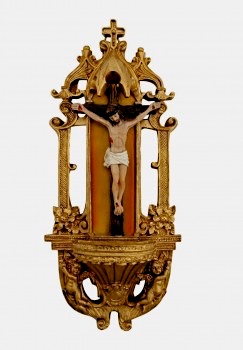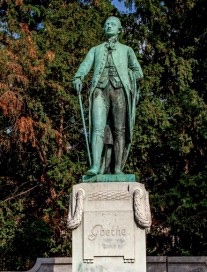“Nowadays the devil no longer has horns, nor a two-sided cape, he no linger smells of sulfur, he doesn’t frighten us with his facade, but rather he does everything he can to make himself seem helpful and agreeable. He doesn’t have, as one might think, the look of a huckster, nor of an eye-winking panderer, nor that of a jolly good fellow with an inexhaustible repertoire of spicy stories. His appearance is always well-groomed, he wears double-breasted suits, his speech is refined…” – Father Cornelius.
 One can almost see the wink and the smirk on the face of Italian author Paolo Maurensig as he begins his dark satire of a community in the mountains where a formidable adversary has established residence, a place where the residents do not even recognize this new resident as an adversary, though he is the devil himself. Telling a story within a story within a story, the author begins by introducing an unnamed young man who has had one “fortuitous” novel which led to his renown, but which has also led to his receiving countless manuscripts from other beginning authors wanting him to read their work and possibly introduce them to a publisher – and then write a preface to their work. The man does not want to be hurtful to these authors and does not want to discard their manuscripts, but he needs time for his own work and more space in which to do that work. Then, unexpectedly, he finds an unopened envelope from Switzerland which contains a hundred typed pages of a book called The Devil in the Drawer. The author is anonymous, saying only that he has been working as a consultant for a small publishing house owned by his uncle and that in 1991 he was in Kusnacht, Switzerland, for a conference honoring the thirtieth anniversary of the death of Carl Gustav Jung. The sender of the manuscript goes on to describe his meeting there with one of the speakers, Father Cornelius, who presented his belief that the devil can blend in among people and play multiple roles, even borrowing the appearance of people someone might know.
One can almost see the wink and the smirk on the face of Italian author Paolo Maurensig as he begins his dark satire of a community in the mountains where a formidable adversary has established residence, a place where the residents do not even recognize this new resident as an adversary, though he is the devil himself. Telling a story within a story within a story, the author begins by introducing an unnamed young man who has had one “fortuitous” novel which led to his renown, but which has also led to his receiving countless manuscripts from other beginning authors wanting him to read their work and possibly introduce them to a publisher – and then write a preface to their work. The man does not want to be hurtful to these authors and does not want to discard their manuscripts, but he needs time for his own work and more space in which to do that work. Then, unexpectedly, he finds an unopened envelope from Switzerland which contains a hundred typed pages of a book called The Devil in the Drawer. The author is anonymous, saying only that he has been working as a consultant for a small publishing house owned by his uncle and that in 1991 he was in Kusnacht, Switzerland, for a conference honoring the thirtieth anniversary of the death of Carl Gustav Jung. The sender of the manuscript goes on to describe his meeting there with one of the speakers, Father Cornelius, who presented his belief that the devil can blend in among people and play multiple roles, even borrowing the appearance of people someone might know.
 The recipient of the anonymous manuscript becomes more and more intrigued with this book, though the subject matter was controversial, even at the time of the conference. The mysterious sender of the manuscript, nicknamed “Friedrich” by the recipient, goes on to describe Father Cornelius’s warning to him to be careful of the choices he makes in his own life, asserting that “Literature is the greatest of the arts, but it is also a dangerous endeavor….The writer can initiate a chain of thought capable of attributing life and intelligence even to a figure everyone considers to be imaginary, such as the devil.” Father Cornelius believes that the devil is subjected to earthly laws and that he can no longer perform magic, but he also believes that the devil still seeks power as an end in itself. If any sort of competition is involved, especially a “pseudo-intellectual competition,” that is just what the devil most wants. “Consequently, the ideal place [to find the devil] is a literary society…a place where vainglory, fueled by envy, grows immoderately, where even the most banal thoughts – as long as they are printed in type – are accepted as absolute truth.” He advises Friedrich to stay away from literary societies, “those dens of iniquity,” then mentions that he knows a place where, in fact, “a whole colony of writers was overcome by a particularly enterprising devil.”
The recipient of the anonymous manuscript becomes more and more intrigued with this book, though the subject matter was controversial, even at the time of the conference. The mysterious sender of the manuscript, nicknamed “Friedrich” by the recipient, goes on to describe Father Cornelius’s warning to him to be careful of the choices he makes in his own life, asserting that “Literature is the greatest of the arts, but it is also a dangerous endeavor….The writer can initiate a chain of thought capable of attributing life and intelligence even to a figure everyone considers to be imaginary, such as the devil.” Father Cornelius believes that the devil is subjected to earthly laws and that he can no longer perform magic, but he also believes that the devil still seeks power as an end in itself. If any sort of competition is involved, especially a “pseudo-intellectual competition,” that is just what the devil most wants. “Consequently, the ideal place [to find the devil] is a literary society…a place where vainglory, fueled by envy, grows immoderately, where even the most banal thoughts – as long as they are printed in type – are accepted as absolute truth.” He advises Friedrich to stay away from literary societies, “those dens of iniquity,” then mentions that he knows a place where, in fact, “a whole colony of writers was overcome by a particularly enterprising devil.”
The real action and the thematic development begin as Father Cornelius tells this story to Friedrich, becoming the third such story-teller within the novel. Naming the mountain village where the action took place “Dichtersruhe,” meaning “Poet’s Repose,” to keep its real name secret, he describes a place where Goethe supposedly stayed for one night, the place where Father Cornelius himself was a vicar ten years ago, replacing an older priest who essentially retired. Father Cornelius was not popular in that village, something he blames on rumors that had preceded his arrival. He soon begins to notice that everyone in town has a writer in the family, and all mail their work to publishers regularly in hopes of seeing their thoughts in print. No one has yet succeeded in this except Marta Bauer, a young woman described as “mentally handicapped” whose illustrated nursery rhymes and illustrations won first prize in a contest. The other writers in the town all display their publishing house rejections on the wall as a matter of pride.
An outbreak of rabies, carried by foxes, coincides with the arrival of Bernard Fuchs (meaning “fox”), a publisher from Lucerne. Father Cornelius, who believes that Fuchs has intuited all his own secrets, is not happy, declaring sarcastically that “It was just the thing in a village of literati: all they needed was a devil of a publisher who, coming from God knows where, would invade Dichtersruhe like a fox in a henhouse.” The leaders of the community are excited, however, especially the semi-retired old priest, Father Cristoforo, and the Burgomaster, who hope that Fuchs will establish a branch of the publishing house in the village. When a literary award with a monetary prize is announced there, life in the village becomes completely undone, a calamity of jealousies, fears, and resentments dividing families and friends and threatening every aspect of society. Father Cornelius’s constant warnings regarding Fuchs are for naught, and he becomes more and more convinced that Fuchs really is the devil in action. The village continues to ignore the fact that Fuchs is living off the village, promising everything they want, and contributing absolutely nothing except dissension.

Miniature font for holy water. Fuchs insisted that these all be removed from a wall display in the house where he was staying.
Throughout the novel, Maurensig keeps the action moving rapidly, while also raising serious questions about the nature of good and evil. His use of symbolism and lively detail allows the reader to see some issues which are often discussed more abstractly by other writers, and his dark sense of humor keeps the reader from becoming overwhelmed by the serious subject matter. (Where else can you see a woman’s complexion described as “pasty and opaque, dotted with blackish bristles like a piece of boiled pork rind.”) The care with which Maurensig organizes and paces this novel is astonishing – it feels like a thriller in places where serious issues are being presented – and the build-up to the conclusion is so carefully done that the discussions of morality which one usually associates with a parable or an allegory feel natural, instead of turgid or intrusive here. Imaginative, finely crafted, and totally different from any other book I have read in years, this one will be high on my Favorites List for this year.
ALSO by Maurensig, reviewed here: THEORY OF SHADOWS and GAME OF THE GODS
Photos. The author’s photo appears on https://www.giunti.it/
Goethe’s statue in Strasbourg, photographed by Philippe de Rexel, is from http://www.otstrasbourg.fr/
The rabid fox may be found here: https://www.nydailynews.com
The miniature font for holy water appears on https://www.amazon.com/


